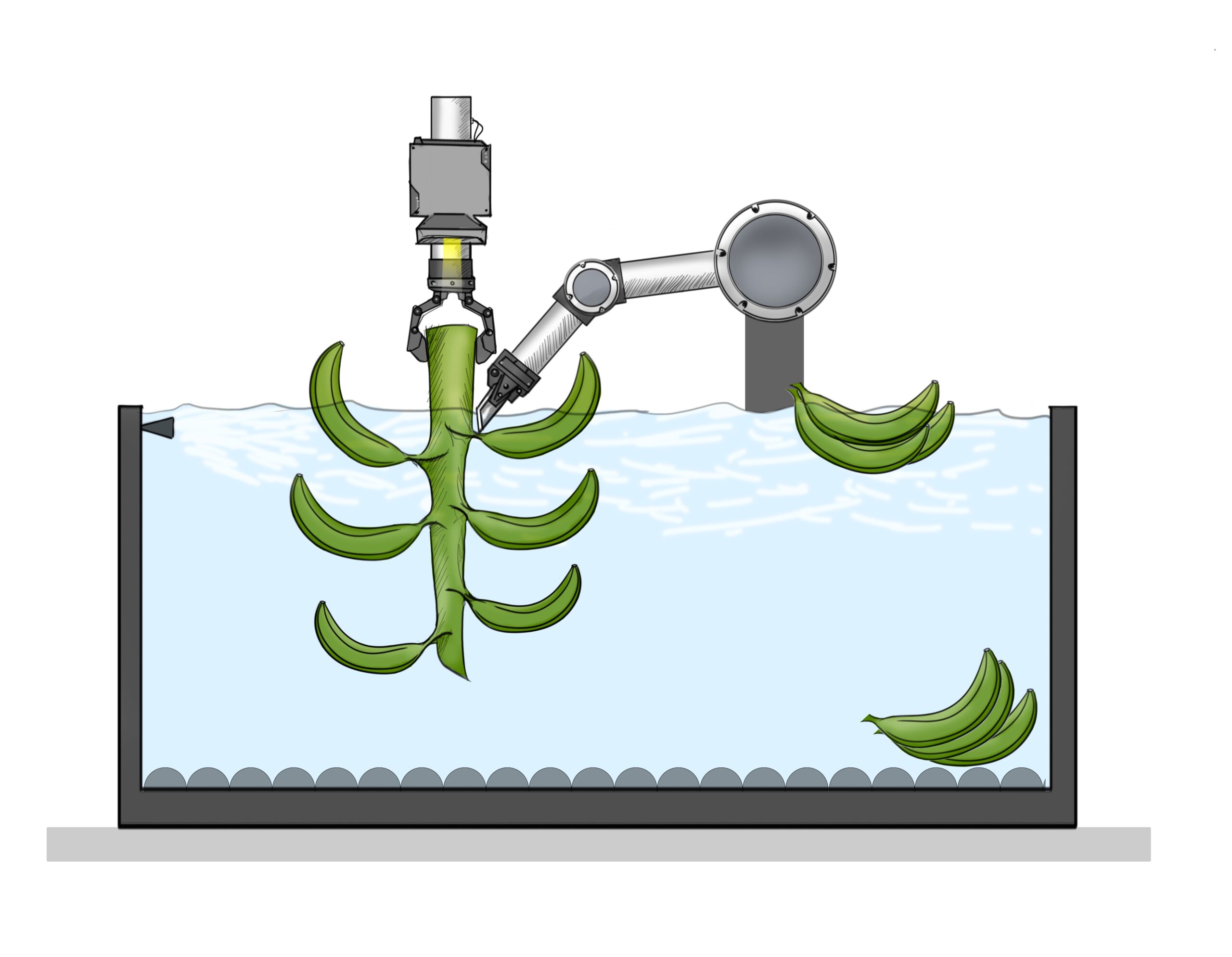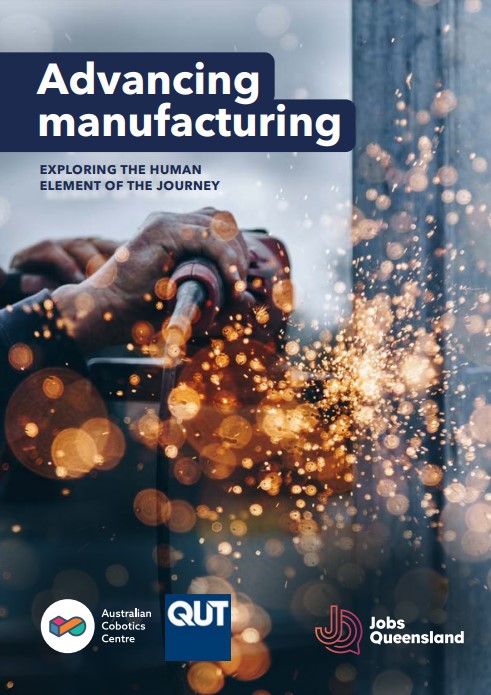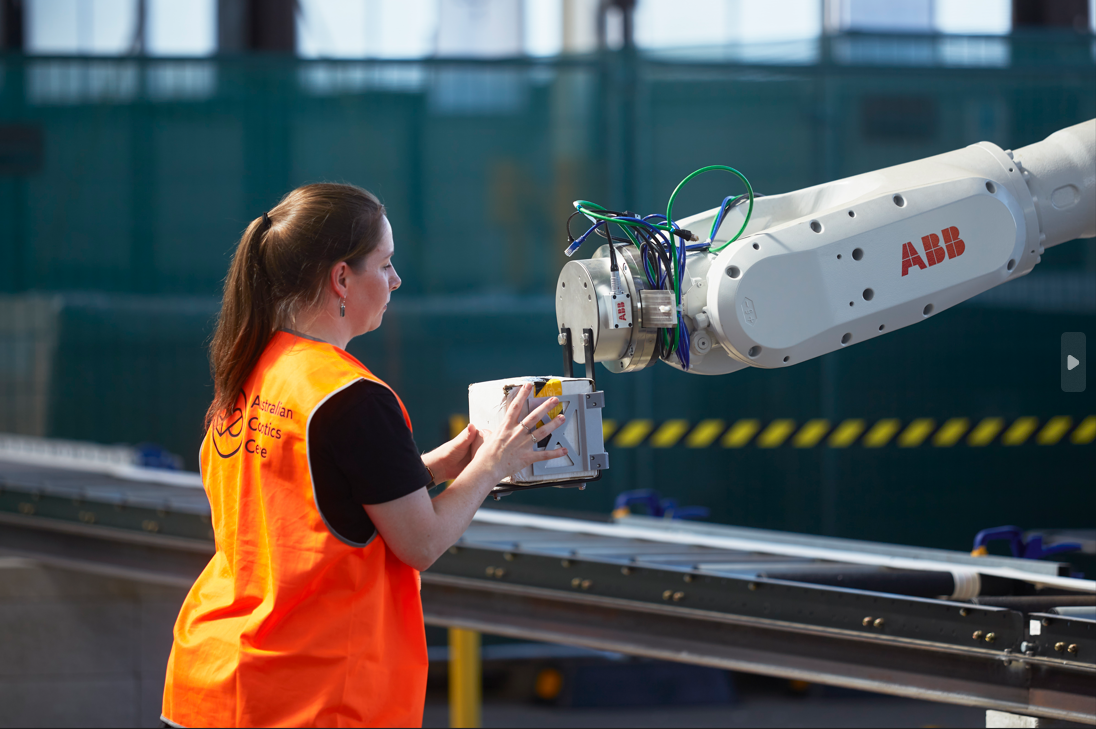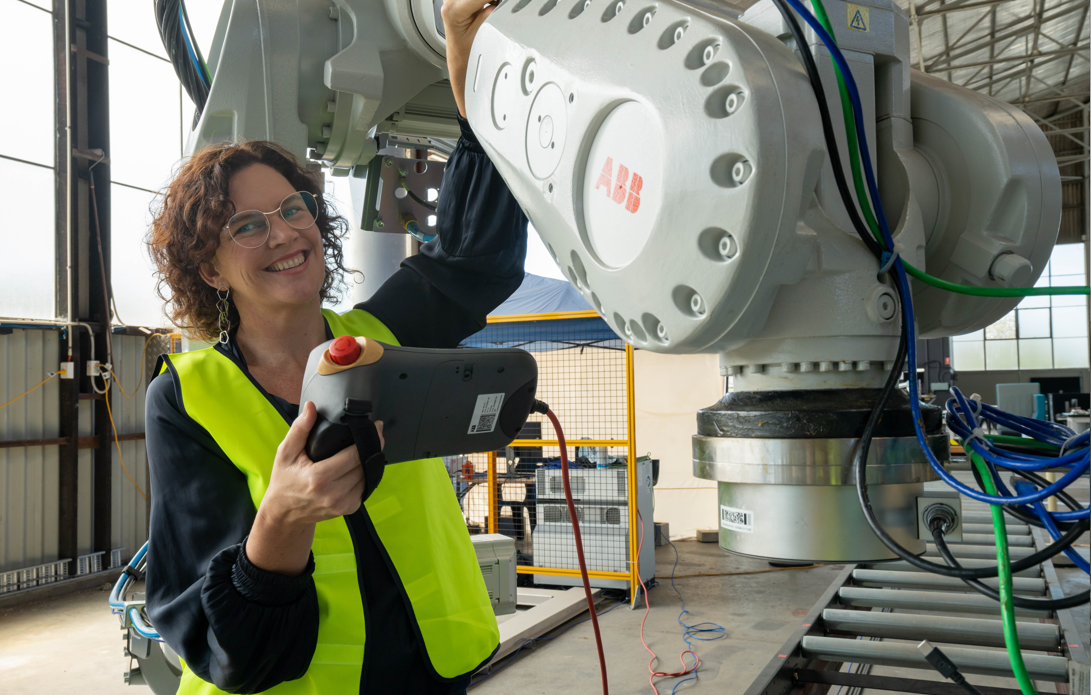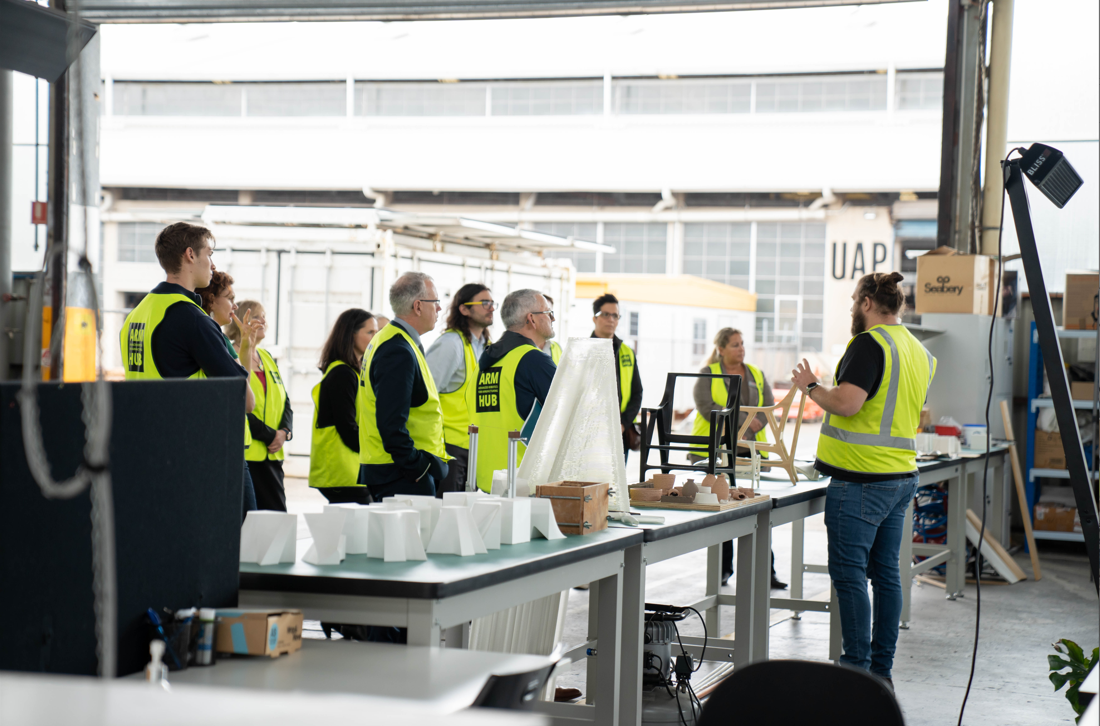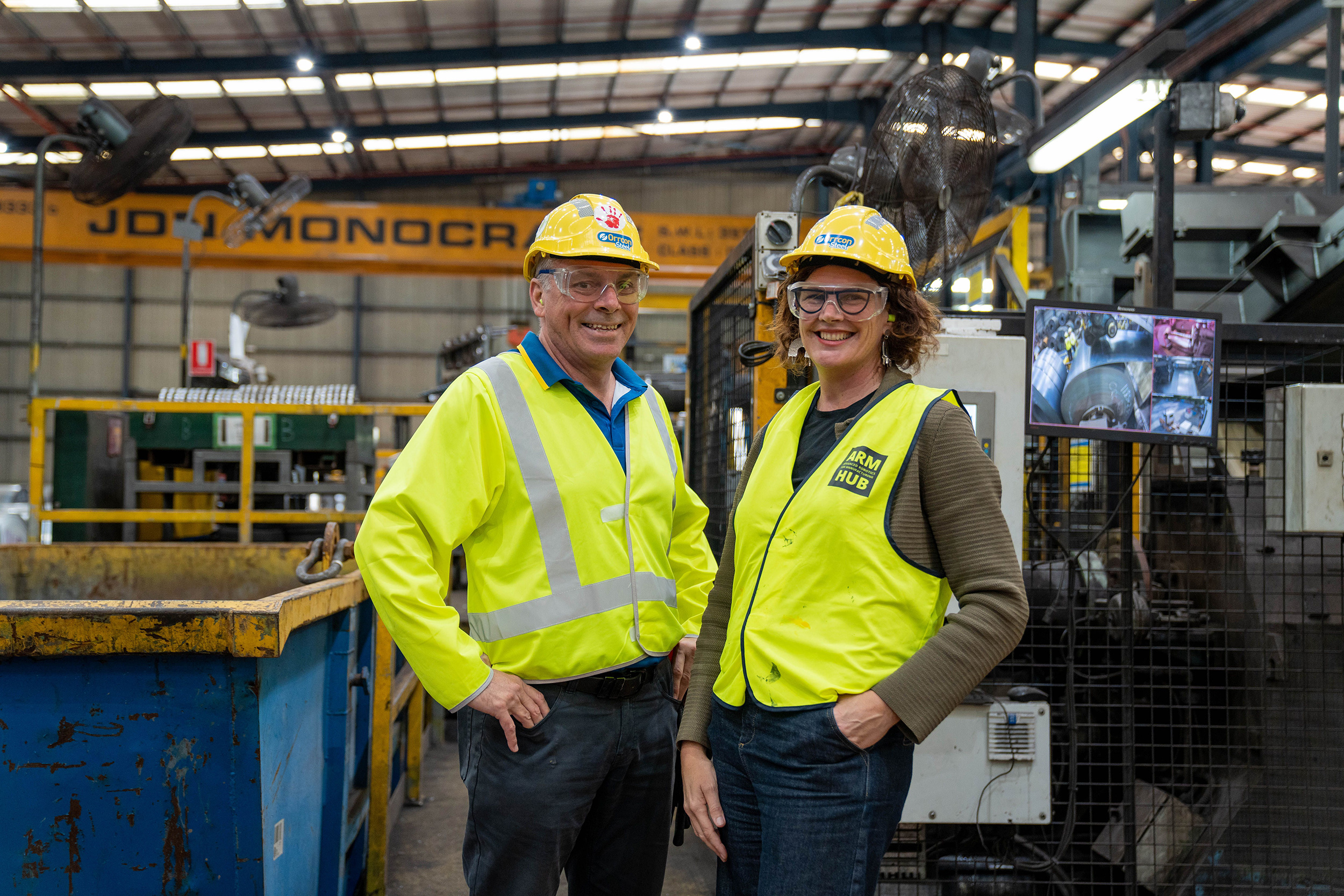Author: Margaret Puls
Jobs Queensland launches Advanced Manufacturing case studies
Around 120 people attended the launch of Job Queensland’s Advancing Manufacturing: Exploring the human element of the journey key findings at ARM Hub today.
 The report documents two Advanced Manufacturing case studies undertaken by the Australian Cobotics Centre to illustrate the opportunities and challenges faced by manufacturing organisations on their 4.0 journey and highlights the importance of manufacturers engaging their workforce to facilitate change and drive growth.
The report documents two Advanced Manufacturing case studies undertaken by the Australian Cobotics Centre to illustrate the opportunities and challenges faced by manufacturing organisations on their 4.0 journey and highlights the importance of manufacturers engaging their workforce to facilitate change and drive growth.
Case Study 1: Watkins Steel-Holovision is a Brisbane company specialising in structural steel and metalwork fabrication, which services multiple industry sectors. Since 2014, when the company commissioned its first line of robotics, the company has experienced growth averaging 20 per cent year on year.
Case Study 2: B&R Enclosures is a Brisbane-based, family-owned company that designs and manufactures stainless steel, steel and plastic enclosures and cabinet solutions used to house electrical and computer network equipment. Digitisation of business processes is a current focus of B&R’s journey toward Advanced Manufacturing, with the company actively moving from paper-based processes to technology-driven solutions for many aspects of their business.
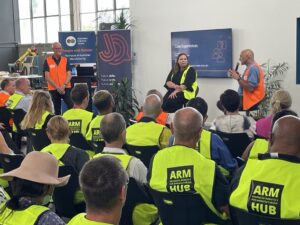 Key findings from the two case studies were:
Key findings from the two case studies were:
- Technology investment
Investment in robotics, automation and digitisation is essential to remain globally competitive. Companies that are investing are expanding into new markets, new product lines or becoming more competitive in existing niche markets.
- Investing in re-skilling
Automation is changing jobs. Continued investment in skilling the current workforce, however, ensures workers can be re-deployed and maintain a career in manufacturing. Such investment must happen both at the level of the organisation and sectorwide. More research is required to better support re-skilling and to address future challenges of digitisation in the workforce.
- Expanding skill sets
Workers with a combination of qualifications (e.g. engineering) and ‘craft’ skills (e.g. welding or boilermaking) are most in demand. By supplementing university qualifications with trade knowledge and craft skills, designers and engineers are better able to understand problems, innovate and produce more practical solutions.
- Training partnerships
Partnerships with educational institutions (e.g. schools, TAFEs and universities) and professional associations are essential to building the skills required in the future workforce. These partnerships are also critical to addressing labour shortages and attracting more diverse workers into manufacturing.
- Re-branding manufacturing work
A communication and attraction strategy is needed to promote emerging career opportunities, driven by robotics, automation and digitisation, and to re-frame negative perceptions in the labour market about manufacturing jobs.
- Diversity strategies require research
The number of women in manufacturing appears to be growing and the workforce is becoming more diverse (as noted by those working within it); however, increasing diversity seems to have largely occurred organically. There are few formal strategies to increase diversity and limited research on the barriers to creating a more diverse workforce. More research is required to support organisations and inform their future strategies, including attraction and retention strategies for under-represented groups such as women, workers with a disability, First Nations people and older workers.
- Leader-driven organisational change
Senior leaders play a pivotal role in shaping organisational cultures in which technology has been embraced as a means by which the organisation can innovate. The behaviour and commitment of leaders drives the ‘mindset shift’ that is required for workers to embrace automation and digitisation not as a threat but as an opportunity to improve the way work is done.
- Capabilities for managing the external environment
Manufacturing capability can be further strengthened by developing skills in dealing with the external environment of the business. For example, managing cash flow, accessing finance and investment, making timely adoption of technology, managing digital threats such as cyber attacks, negotiating or adapting to supply chain opportunities.
Mr Des Watkins, Managing Director, of Watkins Steel and Kimberley Davis, Group HR Manager of B&R Enclosures discussed the findings with ACC Research Program Co-Lead (Human-Robot Workforce program), Professor Greg Hearn. Des spoke of the importance of preparing the future workforce for flexibility and Kimberley called for multi-disciplinary teams, such as engineers, HR workers and others, to collaborate in implementing 4.0 solutions.
 ARM Hub COO Mr Samuel Jesuadian presented on outcomes of Advanced Manufacturing projects at ARM Hub and led a small group on a tour of the ARM Hub factory.
ARM Hub COO Mr Samuel Jesuadian presented on outcomes of Advanced Manufacturing projects at ARM Hub and led a small group on a tour of the ARM Hub factory.
The Advancing Manufacturing: Exploring the human element of the journey report also details progress against Priority Action Areas identified in JQ’s 2018 Advancing Manufacturing Skills: A Skills, Training and Workforce Development Strategy for the Manufacturing Industry in Queensland.
Robots and dance combine at ARM Hub
A large industrial robot and human dancer will perform an exclusive dance work before a crowd of 170 of Australia’s top roboticists and manufacturing industry leaders in Brisbane tonight.
The interactive ‘choreorobotic’ performance is a collaboration between QUT’s robotics Professor Jonathan Roberts and Dr Steph Hutchison, whose choreographic work has a focus on robotics, AI, motion capture and animation.
“I was fortunate to receive an Australian Network for Art and Technology (ANAT) Synapse residency and be supported by the Advanced Robotics for Manufacturing (ARM) Hub and QUT to co-create this performance,” Dr Hutchison said.
“Artists and scientists approach creativity, exploration, and research in different ways and from different perspectives – which we definitely need to explore in the digital age.”
Cobotic improvisation draws on dance improvisation and choreographic methodologies to research how humans might predict the movement of their robot collaborators.
“We’re not talking about a ‘Dancing with the Stars’ type of routine here,” said Professor Roberts.
“This is an interactive performance between robot and human in an industrial setting.”
“It’s about furthering our understanding of how people can predict robotic movements, which will help to better integrate people and robots in the workplace.”
QUT Senior Research Engineer Dr Dasun Gunasinghe and PhD candidate Marisa Bucolo are also involved in the performance.

Robots who work collaboratively alongside humans are known as cobots, and the exclusive performance will mark the highlight of the official launch of the Australian Cobotics Centre, an Australian Research Council-funded Industrial Transformation Training Centre based at QUT, the University of Technology Sydney and Swinburne University of Technology.
“Cobots can be used to do the parts of a job that are dangerous or require higher levels of physical strength, or that are highly repetitive, potentially reducing injury and incident rates,” said Professor Roberts, who heads up the new Centre.
“Collaborative robotics will benefit Australian companies, especially small businesses who will win on process innovation and lower costs, and manufacturing workers whose jobs will become safer and higher-skilled – and the economy benefits through the growth of jobs and exports.”
ARM Hub CEO Associate Professor Cori Stewart said she was delighted for ARM Hub to support cutting edge events that will further the use of robots in manufacturing.
“Queensland is recognised globally as a robotics powerhouse, with QUT the top robotics research and teaching university in Australia and CSIRO’s Robotics and Autonomous Systems Group based in Brisbane,” Dr Stewart said.
“Innovative collaborations such as this will only further our leadership and help us attract top robotics talent to Australia.”
The ANAT Synapse program involves Australian science organisations hosting artists in residence, leading to profound artistic and professional development for the participants, while also building a sustainable support base for interdisciplinary creative collaboration in Australia.
The ANAT Synapse program is supported by ANAT and ARM Hub, and is made possible through the generous support of the Copyright Agency’s Cultural Fund.
Images: Via DropBox
NEW RESEARCH: Augmenting the bottom line with extended reality technologies
Many Australian small-to-medium manufacturers are yet to realise the benefits of low-cost extended reality (XR) technologies, says Anthony Franzè, Industrial Designer and Project Coordinator at the Advanced Robotics for Manufacturing (ARM) Hub.

MR Franzè is lead author of a new research publication on the use of technologies such as augmented reality (AR), mixed reality (MR), and virtual reality (VR) in manufacturing.
“Some innovative Australian manufacturers are taking advantage of XR technologies, to produce better quality, highly customised, low-volume, and bespoke products to service niche sectors of the global supply chain,” he said.
“However, uptake remains low, despite the potential benefits across many facets of manufacturing, such as product design, prototyping, training, maintenance, fabrication and assembly.”
He said this was mostly due to the time and resource constraints manufacturers face, and unfamiliarity with how these industry 4.0 technologies (advanced digitalisation) can be best applied in their processes.
The terms ‘AR’ and ‘MR’ are often used interchangeably. Both technologies enable synthetic overlays to be applied onto the real environment, while VR is a fully enclosed synthetic experience.
Mr Franzè is employed at ARM Hub while completing his PhD at QUT, which focuses on augmented fabrication and creating an Industry 4.0 XR framework for Australian custom manufacturers.
“My PhD explores how immersive technologies can improve Australian manufacturers’ design to fabrication processes,” Mr Franzè said.
“The technology is very powerful in the sense that it overlays 3D virtual information at scale and directly on the context of what you’re working on, removing any task ambiguities.”
Mr Franzè is the lead designer on an ARM Hub project with Young Guns Container Crew (YGCC), which used AR to simulate the design for a new container packing and unpacking tool that was demonstrated in digital simulations to potentially double productivity.

The project team developed a new ‘cartridge’ design, which allows a forklift to supply up to two empty pallets at a time, integrated rollers, a wrapping station, and an integrated blocker device.
The team mocked up their distribution centre, containers, and the new cartridge tool in a 3D CAD (computer-aided design) model and transitioned the data into an augmented reality environment using Microsoft HoloLens 2 headsets.
The simulation used in the development of the tool tracks the actions and interaction of each aspect of container de-stuffing.
Each unpacker, forklift, container, and pallet are represented as an agent within a distribution centre.
“We showed what the product would look like at various stages of utilization in the distribution centre,” Mr Franzè said.
“We had YGCC’s frontline team come in, and they could put the headsets on, and they could walk around in the virtual future distribution centre environment with two people at a time.
“The team could discuss what it would be like to use the ‘cartridge’ device in different stages of operation, get a feel for it and develop a shared understanding of the devices’ potentials. The AR was hugely beneficial for the team in terms of being able to engage and understand what the device is, because they didn’t just have to imagine being with it, they could actually be with it.”
Mr Franzè said these technologies helped reduce reliance on 2D drawings and physical templates and are also valuable for quality assurance tasks and facilitate collaborative environments.
“Also with training, AR and VR are very helpful in training the workforce and upskilling existing staff,” he said.

“I use it a lot to design and fabricate products, and to simulate and visualise. I find that AR & VR have a positive impact on the co-development process.”
Mr Franzè said working at the ARM Hub was invaluable, enabling him to apply research learnings about the technology and development process to real-world situations.

He recently ran a design workshop at ARM Hub in collaboration with Australian AR/MR software development company Fologram, staff from QUT, the Australian Cobotics Centre and Brisbane-based bespoke public art manufacturers UAP.
“A group of 10 of us got together and fabricated quite a complex structure with all of us using Microsoft HoloLens 2 mixed reality headsets,” Mr Franzè said.
“There were 10 of us fabricating at the same time, and we had never used that sort of fabrication process before, but within an hour, the ten of us, collaborating as a sort of hive mind, built this amazing structure.
“It was a real eye-opener on the power of technology, and we got quite a good result.”
Mr Franzè says he sees immersive technologies as a tool to synergise human-robot and AI collaboration to assist manufacturers across tasks.
“I think immersive technologies will become a ubiquitous part of our society, of our lives – much like smartphones are now,” he said.
“I think it will enhance our capabilities and extend the human experience beyond what is currently possible”.
Mr Franzè is the lead author of a new research paper, ‘Employing AR/MR Mockups to Imagine Future Custom Manufacturing Practices’, co-authored by QUT colleagues Associate Professor Glenda Amayo Caldwell, Dr Müge Teixeira, and Associate Professor Markus Rittenbruch.
Images for media: Via DropBox
More information:
Anthony Franzè, Project Coordinator and Industrial Designer at ARM Hub
E: anthony.franze@armhub.com.au
ARM Hub’s robotics chief wins major STEM award
ARM Hub CEO Associate Professor Cori Stewart has today been announced as one of Australia’s newest Superstars of STEM by Minister for Industry and Science, Ed Husic MP.
Dr Stewart said the Superstars of STEM program pushes to deliver a diverse STEM workforce and ensures the next generation of scientists and technologists have visible role models.

“Australia needs our manufacturing to translate our world-class STEM education into globally leading companies,” Dr Stewart said.
“And if we don’t make the necessary investments now, including having more women enter the industry, we are at risk of the nation becoming a low-wage, low-value service economy.”
Dr Stewart said she was honoured to receive the Superstars of STEM award, as it promotes an issue she is deeply committed to – more women and girls entering STEM careers.
“I founded the ARM Hub with a mission to address Australia’s urgent need to secure high-value STEM industries and highly-skilled STEM jobs that will make our nation and advanced manufacturing nation,” Dr Stewart said.
Minister Husic congratulated the newest Superstars of STEM on stepping into the public arena to help inspire the next generations of diverse young Australians into STEM.
“The need to boost diversity in our science, technology, engineering and mathematics sector is urgent,” he said.
“There are huge skills shortages that can be addressed if we put our minds and collective effort to it – which means we have to draw deeply on our nation’s expertise from all corners of the community.”
“By doing so, we can deliver a stellar boost to our national economy and enable Australia to meet the growing demand for STEM-trained workers.”
“I just know these talented experts and communicators will play their part inspiring Australia’s young people – from all backgrounds – into science and technology.”
Science & Technology Australia Chief Executive Officer Misha Schubert said the program gave women and non-binary talent in STEM crucial skills and confidence to step into expert commentary roles in the media.
“We know it’s really hard to be what you can’t see,” she said.
“That’s why this game-changing program is helping to smash stereotypes of what a scientist, technologist, engineer or mathematician looks like.”
“By becoming highly visible role models in the media, these Superstars of STEM are showing our diverse next generations of young people – especially our girls and non-binary kids – that STEM is for them.”
Superstars of STEM is an initiative of Science & Technology Australia funded by the Australian Government’s Department of Industry, Science and Resources The next 60 Superstars of STEM will join the program in 2023 and 2024.
Through a highly competitive selection process, the program selects 60 women and non-binary STEM experts and gives them the training, confidence, networks and experience to become sought-after media commentators as experts in their fields.
About Science & Technology Australia
Science & Technology Australia is the nation’s peak body representing more than 105,000 scientists and technologists. We’re the leading policy voice on science and technology. Our flagship programs include Science Meets Parliament, Superstars of STEM, and STA STEM Ambassadors.
Media contacts:
Advanced Robotics for Manufacturing (ARM) Hub media contact: Margaret Puls, 0419 578 356
Science & Technology Australia: Martyn Pearce 0432 606 828
Minister Husic office: Marcus Strom 0499 829 795
Images for media: Via DropBox
ARM Hub teams up with Azcende to streamline US markets for critical Australian manufacturing
ARM Hub and Azcende Venture Capital have formalised a partnership to accelerate new business and emerging and innovative technologies for national security and critical infrastructure.
“ARM Hub and Azcende will collaborate in the development of programs and networks and leverage funding for Defence, Defence Industry, advanced manufacturing, and related supply chains to help secure a pathway into US markets for local manufacturers,” Dr Stewart said.
Azcende, a new Venture Capital (VC) fund established by former Deloitte Smart Cities and Cyber Risk Partner, Lani Refiti; entrepreneur and technology leader Alok Patel; software developer and start-up advisor Peter Laurie; and US-based engineer Matt Yeoh, is tapping high net worth investors for its $30 million fund.
Azcende CEO and Managing Partner Alok Patel said the fund will focus on investing in Australian critical and emerging technology businesses that can take advantage of the United States marketplace.
“Azcende has partnered with ARM Hub due its success in positioning itself with strong technological expertise, arising from its deep academic networks,” Mr Patel said.

“With Azcende’s focus on national security and critical Infrastructure, we are excited to bring global commercialisation experience combined with venture investments to activate critical and emerging technologies together with ARM Hub’s technological expertise.”
He said Australian industry faces major problems, from supply chain security, staffing availability and skill levels.
“Emerging technology presents the most pragmatic manner to solving these issues – whether it be AI, reducing the complexity of skills required, or robotics and autonomous systems increasing the production capacity of smaller teams,” Mr Patel said.
“Manufacturing is core to industry. It ensures that we can locally develop product and services to bolster key supply chains for critical industries, in particular Defence, whose supply chain is broad and strategic.
“However, industry struggles with adopting new technologies due to their disruptive nature which forces significant change to how a business operates.
“Helping to establish these emerging technologies as future businesses is essential to enabling adoption and achieving Australian sovereign capability.”
Mr Patel said Australia’s track record of ingenuity, such as the invention of WiFi, there is a real opportunity to establishing Australia as a net exporter of intellectual capital.
Dr Stewart said ARM Hub welcomed the partnership.
“ARM Hub and Azcende share a commitment to accelerating the manufacturing readiness level of technology and overcome brakes and barriers to commercialisation, working predominantly in technologies that are relevant to Defence and Defence industries, including medical, transport, energy, and space to achieve their vision,” Dr Stewart said.
“Azcende will further support the work we do with manufacturers by providing commercialisation advice and business networks with a view to supporting export to a North American market.”
More information:
Associate Professor Cori Stewart, CEO, ARM Hub
E: cori.stewart@armhub.com.au M: 0400404803
Mr Alok Patel, Chief Executive/Managing Partner, Azcende
E: alok.patel@azcende.com M: INT +61 410 652 974
Images for media: Via DropBox
Arming Australia’s manufacturing industry to support the Warfighter
A dedicated Defence Technology Accelerator program will address key gaps in the defence manufacturing ecosystem to best equip the Warfighter, says ARM Hub CEO Cori Stewart.
“There is an urgent need to harness the power of technology to support Australia’s defence capability to be better protected, mobile, and connected,” Dr Stewart said.
She said Australia’s manufacturing industry and SMEs are rich in ideas and vision but face major hurdles in engaging with Defence.
“The Accelerator will enable emerging technology providers to develop, demonstrate, and scale-up delivery of innovative Defence solutions in a rapid development process, which is something we don’t have access to at this time.”
Dr Stewart’s call for funding of a Defence Technology Accelerator was supported by Griffith Defence Network’s Professor Adam Findlay AO, Major General (Retired).
“The Griffith Defence Network strongly supports the call to form a Defence Technology Accelerator in Queensland,” Professor Findlay said.
“Such an initiative would greatly increase the rate of technology adoption, and support the build-up of sovereign resilience, through actively promoting the uptake of world-leading Australian Industry Content into Defence.”
ARM Hub is seeking $12 million to establish a pilot Defence Technology Accelerator Program, in collaboration with its university and investment partners.
“It’s not a silver bullet, but it does address some major inhibitors for Australian SME to participate in the Defence Industry,” Dr Stewart said.
“It will make the Defence Supply environment significantly less hostile to Australian SMEs and start-ups; increase sovereign manufacturing capability and Australian industry content; while also boosting capability overmatch.”
The Accelerator addresses key hurdles for SMEs in working with Defence, including the significant investment in time and resources required to meet Defence compliance; the lack of knowledge of Defence procurement and the Defence ecosystem; and the lack of a stable mechanism to form consortia to respond comprehensively to Defence tenders.
Dr Stewart said the Accelerator would house many SMEs simultaneously and actively support the formation of consortia.
“The Accelerator would act as a focal point for a ‘whole-of-ecosystem’ approach to supporting Australian SMEs, and ultimately the Warfighter,” she said.
“It brings together in one program the marketplace of SMEs, primes, the Australian Defence Forces, along with the investment, skills and the talent required to make transformation happen.”
Dr Stewart said Defence was investing significantly in programs such as the MQ-28A Ghost Bat or ‘Loyal Wingman’, the Anduril XLUUV program and the Sovereign Guided Weapons and Explosive Ordnance Enterprise or GWEO.
“Projects such as these are fast-paced, high-technology programs which could generate enormous industry capability benefits if the SMEs pursuing them follow the right development and growth path,” she said.
She said the Accelerator model would be ideal for next-generation technology that needs to be exploited quickly to provide a battlefield advantage and which might need updating or replacing quite rapidly – like sensors on a ‘drone’, or the software controlling a weapon or combat management system.
“Some of these technologies need to be developed rapidly in a process that tolerates risk but also controls costs.”
Images for media (via DropBox)
LAND FORCES 2022
See ARM Hub’s presentation on a Defence Technology Accelerator at Land Forces 2022 Hub
Wednesday 5 October 1130 – 1230 hrs
LAND FORCES Hub 2, Rear of Hall 4, Brisbane Conference and Exhibition Centre
More information:
Associate Professor Cori Stewart, CEO ARM Hub
M: 0400404803 | E: cori.stewart@armhub.com.au
Mr Tim Kelly B.E. (Aero), Business Development and Lead Engineer
M: 0406 195 269 | E: tim.kelly@armhub.com.au
Qld Government helps Brisbane start-up blast into space

Published Friday, 18 November, 2022 at 12:43 PM
Minister for Regional Development and Manufacturing and Minister for Water
The Honourable Glenn Butcher
Brisbane start-up company Valiant Space, which has been supported by the Queensland Government’s Advanced Robotics for Manufacturing (ARM) Hub, is sending locally-made components into orbit, onboard SpaceX, from the Kennedy Space Center at Cape Canaveral.
Minster for Regional Development and Manufacturing Glenn Butcher said the components going into space were a first for an Australian company.
“The Palaszczuk Government will always support good jobs in Queensland and these young guns – space guns, if you will, are tapping into amazing opportunities, with the help from our ARM Hub and funding support,” Mr Butcher said.
“Our Government provides support in many ways and in this instance, the Queensland Government-funded ARM Hub, at Northgate, helped these young entrepreneurs out by providing a workspace to start this fantastic business, as well as assistance in applying for the critical grants that have made this SpaceX opportunity a reality.
“We manufacture things for Queensland, we manufacture things for Australia and now we’re manufacturing things for outer space,” he said.
Nudgee MP Leanne Linard said the local ARM Hub is making Queensland a nation-leader in robotics manufacturing.
“The Valiant Space team is just one business based here at the hub in Northgate and I’m looking forward to seeing the fantastic advancements and products to come from this Palaszczuk Government initiative.
“We know our Queensland manufacturers are some of the best in the world and now – perhaps – some of the best in space!”
Valiant Space co-founder and CEO Andrew Uscinski, 24, said one of the challenges for new businesses in the space industry was the need to validate your product by successfully launching it into space.
“We’ve developed Australia’s first in-space chemical thruster for satellites made with non-toxic propellants, and right now our focus is proving it can withstand orbit,” Mr Uscinski said.
The first step in this validation process will occur on a valve that is an integral part of Valiant’s thruster, which will be sent into orbit with SpaceX on board Australian space services company Skykraft’s rideshare service.
Once the valve demonstrates it can survive a violent launch, 6-G gravitational force, extreme vibrations, and a wide range of temperatures on its journey into space, Valiant Space’s full thruster will be launched on a subsequent orbital mission in mid-2023.
Valiant’s young team of three, Mr Uscinski, fellow co-founder and Chief Technical Officer, Michael Douw, and lead engineer Benjamin Dodd, are mechanical and aerospace engineers who met at the University of Queensland and started their company while they were students.
The Valiant team identified a gap in the market for space propulsion options that used non-toxic propellants.
“Existing options are made from very carcinogenic and difficult-to-handle chemicals which makes them very expensive because of all the development costs,” Mr Uscinski said.
“Our thruster runs on nitrous oxide and propane – like what you would use in a barbecue, but slightly more pure – which gives a comparable performance to the toxic options, but without the need for high-cost handling infrastructure.
“Our solutions will save money at every step of the mission lifecycle, by leveraging a simplified design, rapid manufacturing methods and low-cost propellants.”
The thruster is mounted on the spacecraft to provide the main propulsion system for the satellite and enables companies to perform fast-acting orbit raising and collision avoidance manoeuvres.
“It means satellites can come online quickly, and they stay in their optimal orbit and last longer in space,” Mr Uscinski said.
The Valiant Space team started their operation at the Advanced Robotics for Manufacturing (ARM) Hub workshop in Northgate, Brisbane.
“We were one of their first ARM Hub tenants in November 2020,” Mr Uscinski said.
“ARM Hub offered us flexibility in leasing, which is fantastic for start-ups, and they have such a large warehouse that has allowed us to expand out as needed.
“The staff at ARM Hub have helped enormously by identifying funding opportunities and helping us write our first successful Moon to Mars grant.
“They’ve also helped us gain exposure to a variety of people, including potential investors and Ministers and MPs.”
Valiant Space recently secured $750,000 funding from the Australian Government’s Moon to Mars Initiative supply chain grant, administered by the Australian Space Agency.
The team previously won a Moon to Mars Initiative demonstrator feasibility grant in 2021, to mature their non-toxic thruster technology.
“The first grant helped us to prototype and test our product, which has been instrumental in gaining market traction and momentum,” Mr Uscinski said.
“With this second grant, we will be getting flight validation on our product, build the supply chain, and upscale our propulsion technologies to domestic and international customers.”
The thrusters are 3D printed and almost entirely Australian made.
ARM Hub is funded by the Queensland Government, QUT, CSIRO, Urban Arts Project and Innovation Manufacturing CRC.
ENDS
